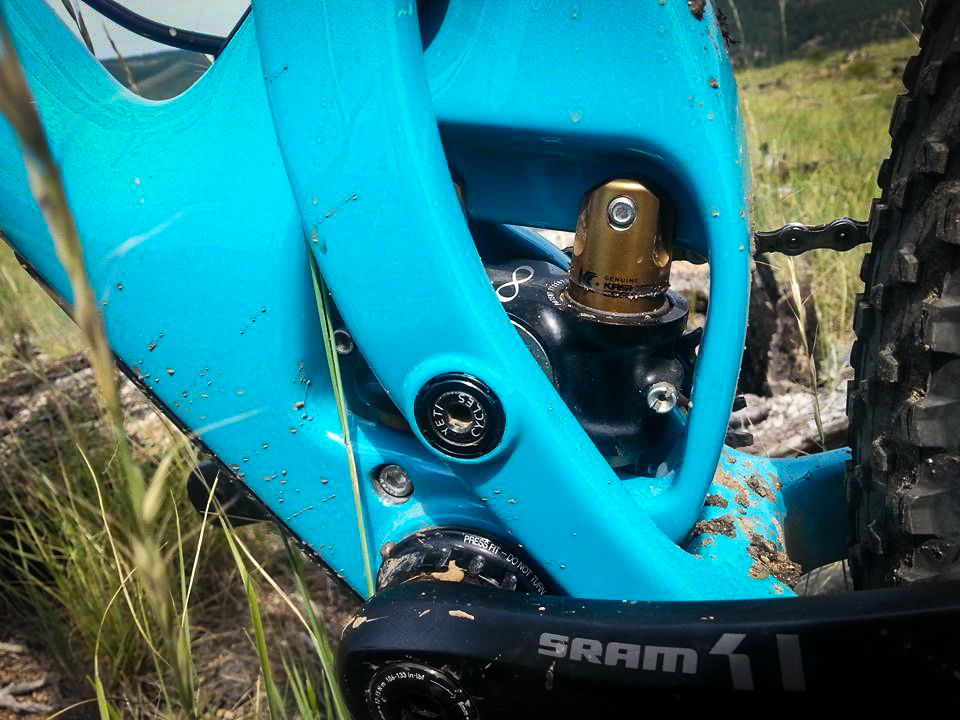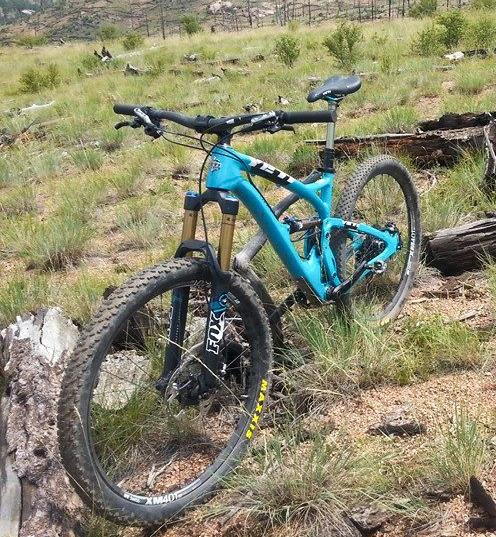On July 17th Yeti shook up the mountain biking world with the announcement of Switch Infinity suspension, a double-barreled Kashima-coated revamp of the wildly popular Switch suspension found on bikes like the venerable SB66 and SB95. Singletracks described the suspension here, but I was fortunate enough to take the bike designed with and for this suspension, the new Yeti SB5c, out for a spin in the Colorado High Country.

Living close to Yeti world HQ has its perks, and one of which is being able to demo this bike technically before it even goes on sale. Golden Bike Shop held a massive bike demo event at the Buffalo Creek trail system, and they were fortunate to score a few of these 5c’s to offer out for a day on the trails–to anyone.
Although I would normally ride a Medium, I was given a Small frame because of availability, which was initially disappointing despite the reassurances that the long top tube (22.6″) made it feel like a bigger bike. And, although I still feel like I would choose a Medium if I were to purchase this bike, I felt right at home on the small. Surprisingly, the small frame never felt uncomfortable.

Initial Impression:
Aside from the unusual and irresistible aesthetics, the very first thing I noticed about this bike was the weight. It seemed amazingly light, right around 26lbs, complete with a Thompson dropper post. My demo came spec’d with top of the line components, but as I climbed effortlessly up Shinglemill I could not help but realize that swapping the aluminum hoops for some carbon ones and “upgrading” the XO1 11spd drivetrain to it’s lighter XX1 brother would make this bike even lighter. That, my friends, seems insane for a 127mm trail bike of this caliber, that also came with a Fox 34 140mm fork and fairly beefy Maxxis Ardent tires. Furthermore, this bike looked really clean, and it is obvious that the three years that Yeti spend proto-ing the SB5c gave them time to scrutinize every line, curve, color, and graphic on the bike. It’s almost too pretty to get dirty. Almost.

Moving out:
Coming from a slightly-heavier 29er with similar geometry and travel, this bike accelerates faster than my own steed… and even other 650b bikes that I have pedaled. It kept its momentum, and I found myself surprised by all of the riders I was passing on the way to the top–a phenomenon that doesn’t happen very often. I’m not slow, per se, but I like to save my energy for those long Colorado climbs. With this bike, however, I did not feel like I had to, and out-of-the-saddle climbing felt natural, grabbing a handful of traction when I stood up and stepped on the gas.
Climbing:

Riding a new bike is always nice, and this was no exception. The 5c shifted crisply and the suspension was quiet and supple. It tackled steep pitches with relative ease, and was nimble over uphill technical sections like no other trail bike I have ridden. Having smaller 650b wheels (compared to 29er wheels) facilitates this, but the 5c seemed to have something extra. Several times when I instinctively started to downshift on a steeper section, my mind and muscles told me to keep it in the same gear. To my utter shock, this bike allowed me to muscle up those sections without feeling like I just spent my last molecule of O2. I still put it in the granny gear sometimes, but less often.
I used the Fox CTD climb setting for the forest service climb to the Shinglemill trailhead, but I found that the “trail” mode was preferable for singletrack that had an occasional chunky section. “Trail” just seems to offer a little more traction, without hemorrhaging efficiency. I rode in the “trail” setting for the majority of my ride, both up and down.
Pedaling:
On the flatter sections at the top of my route, which is the Colorado Trail that connects to Shinglemill at about 7,900ft, the Yeti came alive. A second, very impressive thing that I noticed, is that this bike is both pedalable and pumpable, allowing fast and flowy riding even on winding, undulating terrain. There is no doubt that the Switch Infinity is targeting this small window of suspension, honing the rougher bits better than the original Switch, perfecting an already capable system.
I will say this: the first rock garden that I rolled through on this bike, about 15-20 feet long, felt like I was riding over a waterbed. It was strangely muted without subtracting from the fun you get from plowing over basketball-sized pieces of granite. In a word, it was “trippy.”

Descending:
After climbing for an hour, and pondering just how impressive this bike was when working for me uphill, anticipation was building to see what it had when things got steep in the down direction. The 5c did not disappoint. It rallied the fast and flowy, sometimes rocky, Nice Kitty section of Buffalo Creek. Granted, there are rowdier sections of Colorado to test this bike in (and Yeti did), even in the immediate vicinity, but I worked with what I had access to, and the 5c was killer. The bike accelerated out of corners with speed and precision, though the Maxxis Ardents were working overtime to grab the decomposing granite “kitty litter” trails.
I had to plant my foot on several occasions, which was a result of the decreased traction–and increased speed–that I pushed this bike through. The bike is so light, and so well balanced, that it was eerie on some of the more technical drops and corners, because I simply picked up the front–or the rear–and swung the bike around through tight and gnarly rocks, just waiting to gobble up carbon or ankle flesh. Fortunately, this never happened.
The SB5c was a breeze to ride, and nimble both in the air and when planted on the trail: agile without being twitchy. In fact, if this bike has one fault, it is this: you will have to learn to adapt to the way this bike was engineered–it will probably be lighter and more responsive than what you are already riding.

Jumps and Rollers:
I didn’t have the opportunity to test this bike on any major jumps or long rollers, but I went out of my way to find the steepest, tallest obstacles that I could. The 67 degree head angle inspires confidence, and I have no doubt this bike can take a lot more than what I threw at it.
I agree with other reviews I’ve read, which state that the SB5c rides like it has more travel than 127mm. Proof of concent: before this weekend, Yeti said this bike (and Switch Infinity) had never been raced. Richie Rude rode the SB5c at the Colorado Freeride Festival this weekend, proving that a “mere trail bike” can handle the brutality of Trestle Bike Park in the Enduro World Series (EWS). He took second place immediately behind his friend and teammate, Jared Graves, who rode a similar prototype: a longer-travel 157mm bike with Switch Infinity, that is likely to become an SB6c at some point in the future.

Summary:
The SB5c has already been called a “game-changer” by some reviewers, and has also drawn the ire of many armchair engineers. Of course, no one can speak to a bike’s ability until that rider actually throws a leg over said bike and takes it for a spin. Yeti amassed a small amount of criticism for making such a “short travel” bike, ignoring riders pining for a SB66 replacement or longer-travel “Enduro” bike. (Hint: it’s coming.)
But after riding the SB5c–albeit a very short ride–I am convinced that Yeti is smarter than critics give them credit for. Unless you are in the market for the absolute lightest cross-country bike, or want a mostly-dedicated gravity bike, the Yeti SB5c is designed for almost everyone in between–and I suspect they will sell a lot of them. In the end, that is a how a small bike company gets the capital to make bigger and better bikes in the future. So, kudos to Yeti for making such a capable “everyman’s” trail bike that any rider can grow with over the years, but not easily outgrow. Just ask Richie Rude.

Thanks to Golden Bike Shop and Yeti for an early release demo and for a sweet bike.




















